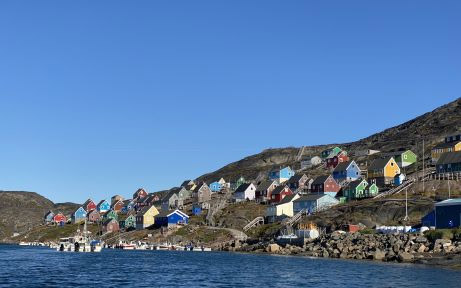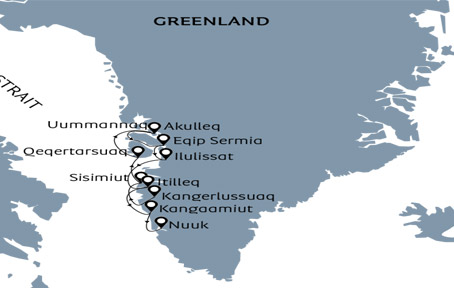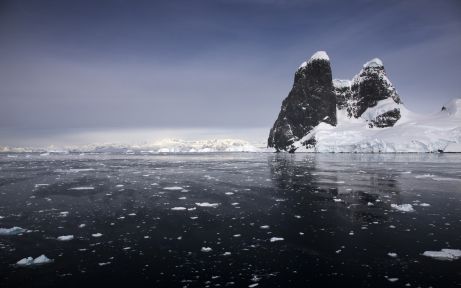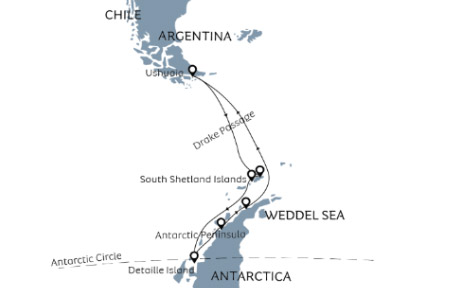Day 1
Kangerlussuaq, Greenland
On the first day of our expedition, we arrive in Kangerlussuaq on the west coast of Greenland, the hub for travel in this vast island.
Situated at the head of a 160km long fjord of the same name, Kangerlussuaq is Greenland's only inland town, and was established as Sondrestrom Air Base/Bluie West-8 by American troops in 1941. Existing largely to service the airport, the town of Kangerlussuaq itself retains a strong 'Cold War' feeling, hinting at its extensive American military use before it was signed over to the Greenlandic Government in 1992. Today Kangerlussuaq is Greenland's largest air hub, with flights arriving daily from Denmark and around the country. It's stable climate and lack of fog makes it ideal as an airport, but it exhibits some of the most varied temperatures in the country, commonly registering the highest summer and lowest winter temperatures due to its inland location.
Upon arrival in Kangerlussuaq, you will be transported to the small port located west of the airport, where the Ocean Albatros awaits at anchor. Zodiacs will transfer us the short distance to the ship, where you will be checked in to your stateroom. After the mandatory safety drill, enjoy dinner and a glass of champagne as we set sail a course for adventure through the 160-kilometre Kangerlussuaq fjord.
Day 2
Sisimiut, Greenland's Second City
After breakfast, Ocean Albatros will arrive in the colourful city of Sisimiut. With around 5,400 inhabitants, it is Greenlandâs second largest city, and one of the most interesting to explore. Paleo-Inuit people have lived around Sisimiut on and off since 2,500 BC, arriving in waves of migration from Arctic Canada. Remnants of turf huts and tent camps from this time can be found thorughout the vast back country which surrounds Sisimiut, including on Tele Island, a short pleasant walk from the harbour.
In 1756, Count Johan Ludvig Holstein established a colony here and called it âHolsteinsborgâ. The oldest part of Sisimiut features town houses from this era, and the oldest dates back to 1756. One of the most culturally significant buildings is the Blue Church, built in 1775, now a landmark in the cityâs historical museum district, arguably the best preserved in Greenland, and the perfect place to discover the Greenland of old.
Nowadays, Sisimiut is an important hub of education and industry, and local factories process the bulk of fish caught in the country (Greenlandâs largest export). The fish processing plant in the harbour is one of the largest in Greenland, and among the most modern in the world. Just beyond the harbour sits the headquarters of KNI, the government-operated company which resupplies the many small settlements throughout Greenland - a vital service in a country with so many remote communties.
The busy city centre of Sisimiut offers a glimpse of what daily life is like in 21st-century Greenland, where seal hunts and smartphones collide. Take a refreshing stroll around Spedjesø and take in an exhibition at the city's cultural centre Taseralik, explore the region's fascinating heritage at the city museum, or visit the Artists Workshop, where savvy shoppers can purchase traditional artworks direct from the artist. As evening falls, we will leave Sisimiut and set a course for the iceberg studded waters of Disko Bay (Qeqertarsuup Tunua) as Ocean Albatros sails for Qeqertarsuaq.
Day 3
Qeqertarsuaq, Disko Island
Nestled below Disko Islandâs 1,000-metre mountains, we pull into port in a beautifully sheltered natural harbour. The place was aptly named Godhavn (âGood Harbourâ) in Danish, while its Greenlandic name âQeqertarsuaqâ simply means âThe Big Islandâ.
For most of Greenlandâs modern history, Godhavn was the political and economic capital of North Greenland (while GodthÃ¥b, now Nuuk, served this role in Southern Greenland). Its importance was due to the vast economic activity generated by whaling in Disko Bay, the preeminent Arctic industry since the 16th Century. As the whaling industry collapsed in the early 1900s, Godhavn lost its political status as all government functions moved south to GodthÃ¥b/Nuuk, and the town was forced to reinvent itself, changing its name to Qeqertarsuaq in 1979 . Today, hunting and fishing are the main industries in Qeqertarsuaq, while tourism is becoming increasingly important. Ferries arrive in the town daily in summer from around Disko Bay, while in winter, access is only by helicopter from nearby Ilulissat.
Qeqertarsuaqâs sweeping red-and-black basalt mountains are radically different to the rolling granite hills which characterize much of Greenland, and provide a much richer soil. Despite being situated well above the Arctic Circle, this rich volcanic soil and the areaâs mild microclimate make it much more green and lush compared to the rest of the country. Locals from all over Disko Bay come to the island in summer to hunt and collect angelica, herbs and mushrooms, and the stunning rock formations and black sand beaches attract visitors from all over the world. The town itself is typically Greenlandic, with quaint multicoloured homes, a splendid museum, and the unique octagonal church nicknamed 'God's Inkpot' (built in the Norwegian stave style). With excellent hiking opportunities, friendly locals, and a fascinating place in regional history, Qeqertarsuaq has a lot to offer.
On the afternoon of our day on Disko Island, we will reposition our vessel slightly to the east and launch our fleet of Zodiacs to explore the coast of Kuannit. Kuannit means 'Angelica' in Greenlandic, referring to the herb which grows abundantly on the rich south-facing slopes of the island. This stretch of coastline is one of Greenland's best kept secrets; with lush greenery dripping with water from mountain springs, spectacularly weird basalt rock formations riddled with caves and waterfalls, and plenty of sapphire-blue icebergs, this secluded section of coast is one of the most spectacular in the Arctic.
From Kuannit, we will set a northerly course towards Uummannaq Fjord.
Day 4
Akulleq and Uummannaq Fjord
At the heart of the maze of islands and fjords north of Nuussuaq Peninsula lies Akulleq - an island whose name aptly translates as 'The Centre'. This island is a geological marvel, a slab of vivid yellow rock amid the crystal blue Arctic waters. The rock is billions of years old, although in this part of Greenland, the age is unremarkable. Understanding rocks of this age is incredibly challenging, however scientists believe that these unique rocks formed in the deep ocean floor, at a time when only single-celled life existed on planet Earth.
Akulleq offers a window into the geological past, as well as the unique ecology of this part of Greenland. Uninhabited and rarely visited, Akulleq is the ideal location to experience pristine Arctic nature. Hunt for tiny saxifrage flowers, watch icebergs drift past and feel billions of years of geological time beneath your feet on this lonely, barren yet beautiful island.
During the afternoon, we will be guided by the patterns of weather and ice as we hunt for a location to explore Uummannaq Fjord by Zodiac. Every corner of this vast fjord system holds jaw-dropping views, vast icebergs, and vibrant rock formations - perfect for exploring on the water!
Day 5
Uummannaq, the Greenlandic Riviera
The small city of Uummannaq sits perched precariously at the foot of a massive mountain. Like the rest of the area, here the mountain reaches vertically out of the icy depths, punching 1170m into the clear blue sky. Uummannaq mountain (translated from Greenlandic as âheart shapedâ) is a true Greenlandic icon, and is a mecca for climbers who visit from all over the world. The city itself occupies a small area of flatter ground at the foot of the mountain, founded by Danish colonists in 1763 â some of the original buildings from this era can still be visited in the harbour-front area. More recently, Uummannaq has become famous in Scandinavia as the home of Santa Claus â the small turf house belonging to the festive hero himself can be reached via a pleasant (if challenging) 2-3h hike out of town.
As for many towns in Greenland however, the Inuit history of the area reaches back much further. At some point around the year 1600, a group of Inuit women and children died in the area (possibly in a boating accident). They were lovingly laid to rest in a rocky cairn under a cliff on the mainland overlooking Uummannaq at a site called Qilakitsoq, protected from the rain and snow, but exposed to the dry Arctic wind which mummified their bodies. They were rediscovered in 1972 by two brothers from Uummannaq (possibly on the advice of elders in Uummannaq, who had preserved rumours of the site for centuries). The mummies were taken to Denmark for analysis before being returned to Greenland, where today they rest in the National Museum in Nuuk. The small museum in Uummannaq did not have the facilities to house such an important find, but several artefacts such as clothing from the archaeological site (as well as a plethora of finds from before, during and after the Qilakitsoq period) are displayed, along with a cabinet of curiosities from the cityâs brief mining boom.
Uummannaq itself is a lively little town. Expect to see enterprising locals selling handicrafts in the grassy town square, while others sell their catch in the local fish market - always a fascinating sight. Watch fishermen bait their long lines as they head out in search of halibut, or load up with provisions for hunting trips deep into the vast fjordlands outside town.
Ensure you are on Ocean Albatrosâ outer decks during our sail-out from Uummannaq â the deep clear blue iceberg-studded waters of the fjord and the dramatic vertical mountains around the city offer some of the best views in Greenland. With a calm microclimate and round-the-clock summer sunshine, not for nothing is this staggeringly beautiful area nicknamed the Greenlandic Riviera!
Day 6
Eqip Sermia
From Uummannaq, we return to the heart of Disko Bay, setting sail towards Eqip Sermia.
Eqip Sermia (a typically descriptive Greenlandic name meaning 'the Glacier at the End of the Fjord') is a relatively small glacier compared to many in Greenland, although it is still a truly vast river of ice, flowing directly from the Greenland Ice Sheet. It is also one of the most active, and ice tumbles off the vast glacier-front almost constantly. Watching the vast cataracts of ice fall into the ocean is a sight which has to be seen to be believed, and the comfortable viewing decks of Ocean Albatros offer the best possible platform to do so... Perhaps with a specially crafted cocktail in hand!
If conditions allow, we will launch our fleet of Zodiacs to approach this vast river of ice, and hopefully experience the roar of the glacier's frequent calvings at sea level (from a safe distance of course)!
From Eqip Sermia, we will reposition slightly southwards during the evening towards Ilulissat, the largest city in Disko Bay and the Iceberg Capital of the World.
Day 7
Ilulissat, Iceberg Capital of the World
This is it. This is why visitors from all over the world come to Greenland. Translated from Kalaallisut simply as âicebergsâ, Ilulissat is rightly known the world over as âthe Iceberg Capital of the Worldâ. Surely no other city on Earth occupies such a spectacular natural setting.
Situated within a short walk of the harbour lies Ilulissat Icefjord, Greenlandâs most famous site. Choked with city-sized icebergs so closely packed one could almost walk across to the other side, Ilulissat Icefjord stretches 70 km from its outlet in Disko Bay near the city of Ilulissat back to the Sermeq Kujalleq glacier. This is the single largest glacier on Earth outside Antarctica, draining 13% of the Greenland Ice Sheet, and producing 10% of all the ice in the Northern Hemisphere (enough water to supply the annual needs of the entire United States). These mind-blowing statistics, together with the indescribably beautiful scenery, have secured the Ilulissat Icefjord designation as a UNESCO World Heritage Site.
While archaeological finds detail the long Inuit habitation of the area, the modern town has steadily flourished in the 280 years since its establishment; legendary Arctic explorer, Knud Rasmussen was born in Ilulissat, and his childhood home now houses the city museum. Today, Ilulissat is Greenlandâs third largest town, with more than 4,500 inhabitants, and is undoubtedly Greenlandâs tourism capital, with more hotel rooms than even Nuuk. The city offers excellent amenities to visitors, with fresh locally caught seafood served in the cityâs cafes and restaurants, and excellent shopping â look out especially for the Artistâs Workshop above the harbour, where you can buy handmade artworks direct from the artist. The city typically experiences dry sunny weather throughout the summer, and there are a variety of well-marked hiking routes around the Icefjord, with options to suit all abilities.
During the visit you will have the opportunity to join a boat trip with a local captain to the Icefjord (optional excursion â charge applies). The journey takes about two and a half hours and is considered the best way to experience the magic of Ilulissat Icefjord up close. If a hike or a trip by boat does not present enough excitement, there is also the opportunity to join a flightseeing excursion in fixed-wing aircraft over the Icefjord (optional excursion â charge applies).
Please note the boat and flight excursions to the Icefjord are not included in the general voyage price. Refer to Price Information for further details.
Day 8
Itilleq - experience small-town Greenland
The settlement of Itilleq, which translates roughly as "the Crossing Place from the Seaâ nestles at the foothills of the mountains and and fjords which line central Greenland's backcountry. Situated just north of the Arctic Circle, Itilleq is one of the many tiny villages dotting the coast of Greenland. The settlement is situated in the heart of the Aassivisuit-Nipisat UNESCO World Heritage Site, which was inscribed due to its ancient Inuit hunting heritage, documenting the entire habitation history of Greenland.
While the turf houses and hide tents have been replaced by colourful modern houses, the lifestyle here has changes little since the Inuit first arrived in Greenland. The local highways are the water and the ice, and the sea and tundra continue to nourish the locals, as they has for thousands of years. Arctic char, reindeer and muskoxen are typical catches, and are all plentiful in the area.
Despite this ancient heritage, locals in Itilleq are still firmly in the modern world, with smartphones, speedy wifi and satellite TV. However, the people of Itilleq remain justly proud of their ancient heritage, and continue to move their culture forward in a modern fast paced world. Locals are pleased to show off their piucturesque town, and visitors are greeted with typical warm Greenlandic hospitality.
Day 9
Kangaamiut and Evighedsfjorden
On the next day of our expedition, we will arrive at the small village of Kangaamiut, an incredibly picturesque settlement in Greenlandâs central Qeqqata region. Surrounded by cold rich waters and a vast back country brimming with game, life in Kangaamiut moves at a slower pace, and locals still live a largely traditional lifestyle, surviving by hunting and fishing. Hike to the heliport atop the hill for stunning views over the town and the surrounding fjordlands, or meet the friendly local people during a display of traditional clothing, foods, and seal-flensing. The artists of Kangaamiut are well-known throughout Greenland, and some of the locals' most splendid work can be viewed in the town's small museum.
In the afternoon, we will sail inland into Evighedsfjorden/Kangerlussuatsiaq, one of the many deep fjords carved between the steep mountains of this region. The Danish name 'Evighedsfjorden' means 'The Eternity Fjord', referring to the vast size of the inlet, while the Greenlandic name 'Kangerlussuatsiaq' translates as 'The Rather Large Fjord' - something of an understatement! Evighedsfjorden stretches around 100km into the glacier-clad mountains, bisecting the large ice cap which overlies much of the land between Nuuk and Sisimiut - Greenland's two largest cities. We will aim to explore on a Zodiac cruise in front of the Evigheds Glacier, which flows into the fjord from the Maniitsoq Ice Cap above. Watch for calvings from the glacier, and guillemots and kittiwakes on the nearby bird cliffs.
Day 10
Nuuk, Greenland - Disembarkation
On the final day of our voyage, we arrive in Nuuk, Greenland's small but perfectly formed capital city. A mixture of skyscrapers and traditional wooden houses, the quaint and the cosmopolitan, Nuuk is a city of contrasts. The vibrant bustling capital of Greenland, Nuuk feels much larger than itâs 19,000 inhabitants, and offers a wealth of experiences to visitors.
After a hearty breakfast, it is time to bid a fond farewell to the Crew and Albatros Expedition Team, and descend the gangway back to dry land with memories of the voyage of a lifetime.


![Odyssey in the heart of Japan's subtropical islands[Osaka - Keelung] Odyssey in the heart of Japan's subtropical islands[Osaka - Keelung]](/images/packages/Odyssey-in-the-heart-of-Japan.jpg)
![Odyssey in the heart of Japan's subtropical islands[Osaka - Keelung] Odyssey in the heart of Japan's subtropical islands[Osaka - Keelung]](/images/packages/extraimages/9836_Osaka-Keelung.jpg)












![10 Days - Delphi & Meteora: Grecian Antiquities Cruise Tour [Athens to Athens] 10 Days - Delphi & Meteora: Grecian Antiquities Cruise Tour [Athens to Athens]](/images/packages/Meteora1.jpg)
![10 Days - Delphi & Meteora: Grecian Antiquities Cruise Tour [Athens to Athens] 10 Days - Delphi & Meteora: Grecian Antiquities Cruise Tour [Athens to Athens]](/images/packages/extraimages/9165_13Days-Delphi-Meteora-Grecian-Antiquities-Cruise-Tour01052022.jpg)
![10 Days - Tahiti & the Tuamotu Islands [Papeete to Papeete] 10 Days - Tahiti & the Tuamotu Islands [Papeete to Papeete]](/images/packages/Rangiroa-French-Polynesia.jpg)
![10 Days - Tahiti & the Tuamotu Islands [Papeete to Papeete] 10 Days - Tahiti & the Tuamotu Islands [Papeete to Papeete]](/images/packages/extraimages/4186_10-days-Tahiti-Tuamotu-Islands27122021.jpg)
![10 Days - Souks & Sherries: Iberia & Morocco [Lisbon to Barcelona] 10 Days - Souks & Sherries: Iberia & Morocco [Lisbon to Barcelona]](/images/packages/Lisbon1Portugal.jpg)
![10 Days - Souks & Sherries: Iberia & Morocco [Lisbon to Barcelona] 10 Days - Souks & Sherries: Iberia & Morocco [Lisbon to Barcelona]](/images/packages/extraimages/4360_10Days-Souks-Sherries-Iberia-Morocco27092021.jpg)
![10 Days - Sicilian Splendors [Rome to Rome] 10 Days - Sicilian Splendors [Rome to Rome]](/images/packages/Rome.jpg)
![10 Days - Sicilian Splendors [Rome to Rome] 10 Days - Sicilian Splendors [Rome to Rome]](/images/packages/extraimages/9697_10Days-Sicilian-Splendors29092021.jpg)
![10 Days - Treasures of Southern Spain & Morocco [Barcelona to Lisbon] 10 Days - Treasures of Southern Spain & Morocco [Barcelona to Lisbon]](/images/packages/Cartagena-Spain.jpg)
![10 Days - Treasures of Southern Spain & Morocco [Barcelona to Lisbon] 10 Days - Treasures of Southern Spain & Morocco [Barcelona to Lisbon]](/images/packages/extraimages/9362_10Days-Treasures-Southern-Spain-Morocco30102021.jpg)
![10 Days - Monteverde Cloud Forest & Arenal Volcano Cruise Tour [Colon to Puerto Caldera] 10 Days - Monteverde Cloud Forest & Arenal Volcano Cruise Tour [Colon to Puerto Caldera]](/images/packages/Panama-Canal-Panama.jpg)
![10 Days - Monteverde Cloud Forest & Arenal Volcano Cruise Tour [Colon to Puerto Caldera] 10 Days - Monteverde Cloud Forest & Arenal Volcano Cruise Tour [Colon to Puerto Caldera]](/images/packages/extraimages/9894_11Days-Monteverde-Cloud-Forest-Arenal06022021.jpg)


![10 Days - Impressionist France [Bordeaux to Amsterdam] 10 Days - Impressionist France [Bordeaux to Amsterdam]](/images/packages/6-bordeaux-france)
![10 Days - Impressionist France [Bordeaux to Amsterdam] 10 Days - Impressionist France [Bordeaux to Amsterdam]](/images/packages/extraimages/7496_6-map-impress_france_5_20_2024)
